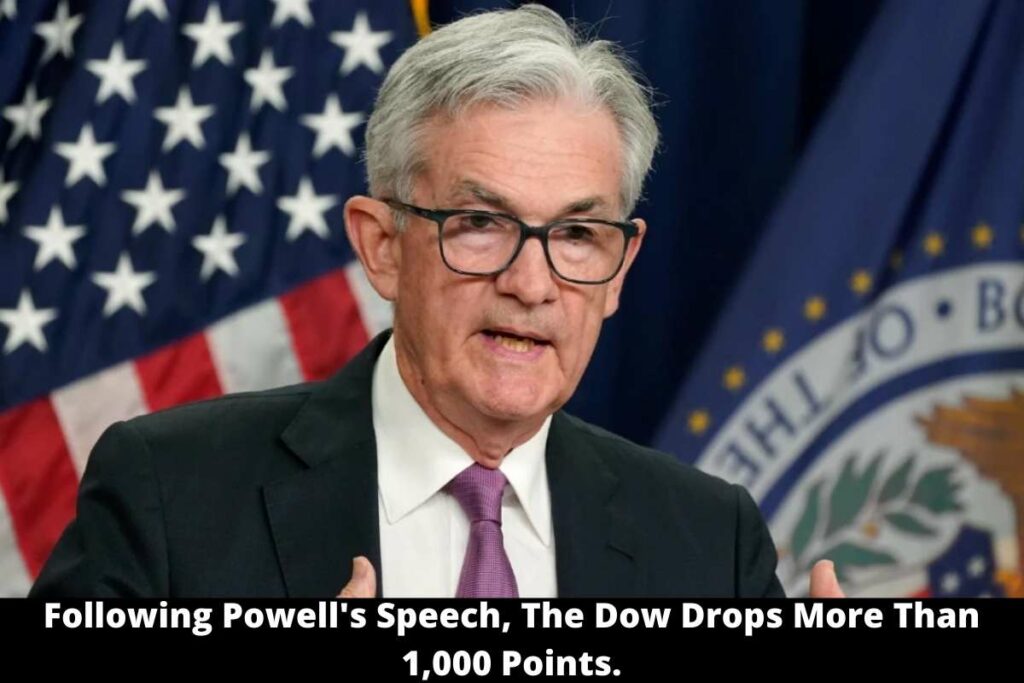More than 1,000 points were lost on the Dow Jones Industrial Average. Jerome Powell, the chairman of the Federal Reserve, promised on Friday to continue pursuing the fight against inflation, even at the expense of economic expansion. Mr. Powell stated in a much-awaited speech that the Fed must keep interest rates high and keep hiking them until inflation is under control. Investors who believed inflation had peaked and the Fed would switch from hiking rates to decreasing them at some point next year were disappointed by his comments.
Major stock index losses for the past two weeks came to an end on Friday, effectively wiping out the market’s gains since late July. Amazon.com and Netflix both fell more than 4% for the day, a particularly harsh blow to technology companies that were flying high earlier this summer. The Dow dropped 1,008.38 points, or 3%, to 32283.40, the most the blue-chip index has dropped in a single day since May. To reach 4057.66, the S&P 500 dropped 141.46 points or 3.4%. The Nasdaq Composite, which focuses on technology, fell 497.56 points, or 3.9%, to 12141.71.
The indices didn’t fluctuate much prior to the speech, but they gradually fell throughout the speech and into the closing bell. Following an up-and-down ride in which investors weighed concerns over Fed tightening against economic data that indicated to underlying resilience in the U.S. economy, all three indices lost more than 4% of their value for the week. Mr. Powell’s remarks at the Fed summit in Jackson Hole, Wyoming, showed how the institution is gearing up to leave behind a period of swift and significant rate increases and possibly enter one in which it concentrates on achieving an interest-rate level that slows hiring, spending, and growth before maintaining that level for a while.
Michael Arone, the chief investment strategist at State Street Global Advisors, said: “The biggest surprise here is that markets were prepared for Fed Chair Powell to talk tough on inflation, yet are reacting negatively after he did exactly that.” “It seems investors were stupidly hoping for a Powell-pivot, but he doubled down on the Fed’s credibility in combating inflation,” said one analyst. The S&P 500’s 11 sectors were all down for the day on Friday, and only five of the index’s equities managed to post gains. This resulted in broad drops in the stock market.
The tech sector was the most severely impacted since its shares are particularly susceptible to rising rates. Alphabet, which owns Google, decreased by more than 5%. Both HP and the semiconductor manufacturer Nvidia experienced a 9% decline. After the personal computer manufacturer warned of a declining PC market, Dell Technologies saw a 14% decline. Stocks in the travel and leisure industry were also under pressure, with Carnival and Caesars Entertainment both dropping more than 5%. Despite its losses this week, the S&P 500 is still up 11% from its June low. Stocks rose throughout the majority of the summer on expectations that the Fed could soften its stance against inflation, a generally strong corporate earnings season, and a few encouraging data releases.
After data revealed that the economy declined less than previously estimated in the second quarter, indexes enjoyed advances on Thursday. Mr. Powell said the next rate decision “would depend on the totality of the incoming data and the changing view,” but he did not explicitly address the prognosis for the Fed’s upcoming policy meeting in September. It will probably make sense to limit the rate of increases at some point as the attitude of monetary policy tightens further. Investors will examine the monthly jobs report, which is due on September 2, for any indication that the labor market is loosening up before the central bank’s upcoming meeting.
They will also receive a new inflation reading. According to the most recent consumer price index report, inflation modestly decreased in July after reaching a four-decade high. Before declaring that inflation is truly declining, the Fed has stated that it needs to see further proof that the economy is slowing down. Officials will likely discuss whether to raise interest rates by 0.5 or 0.75 percentage points at the upcoming Fed meeting. According to futures markets, traders have mixed expectations, with around 60% predicting a higher increase and about 40% anticipating a smaller, half-point gain. According to Brian O’Reilly, head of the market strategy at Mediolanum International Funds, “they won’t want to be known as the central bank that overlooked inflation or even encouraged inflation higher.”
After Mr. Powell’s speech, the yield on the two-year US Treasury note, which is closely related to expectations for the Fed’s benchmark interest rate, shot higher and eventually closed at 3.391%, up from 3.372% on Thursday. Bond yields and prices follow different trajectories. The 10-year yield increased slightly from 3.023% on Thursday to 3.034%. That prolonged the short-term-long-term yield inversion, a crucial bond market recession indicator. Fresh data released on Friday indicated that the Fed’s favorite inflation indicator, the core personal consumption expenditures price index, came in slightly below estimates, suggesting that inflation pressures may be moderating a little.
For more news like this stay tuned with newsconduct.com

